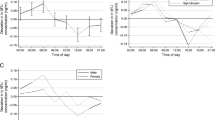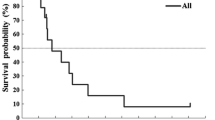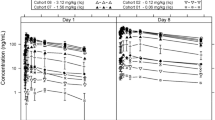Abstract
Initial experimental and clinical studies have indicated that 5-fluorouracil (5-FU) toxicity can be reduced by delivering 5-FU at around 4 a.m. More recent data have suggested that the toxicity might be reduced even more with delivery at around 9–10 p.m. The current study determined the maximum tolerated dose (MTD) for 5-FU and leucovorin (LV) delivered as a continuous circadian infusion over 14 days every 28 days, with the peak of the infusion occurring at around 3–4 a.m. The peak drug delivery was shifted to 9–10 p.m. in all patients developing toxicity of ≥grade II (Eastern Cooperative Oncology Group) to determine if this timing further reduced toxicity and enabled increased dose intensity. A total of 14 patients with metastatic adenocarcinoma received an admixture of 5-FU and LV via a programmable portable infusion pump, with 62.5% of the 24-h dose being given over 7 h around the infusion peak. The starting dose level of 5-FU (200 mg/m2 daily) and LV (5 mg/m2 daily) was that established as the highest tolerable dose rate in a previously reported phase I study using a 14-day flat infusion of 5-FU and LV. The LV dose was first escalated to 20 mg/m2 daily, followed by escalations of the 5-FU dose. A total of 51 courses were evaluable for toxicity. The dose-limiting toxicity was oral mucositis and hand-foot syndrome. More dose intensity could be delivered using a circadian infusion peaking at around 3–4 a.m. than was possible with a flat infusion of these drugs. Toxicity was redouced even further with peak drug delivery at around 9–10 p. m. The recommended dose for phase II studies using this schedule is 250 mg/m2 5-FU daily and 20 mg/m2 LV daily with the peak of the infusion occurring at 9–10 p.m. This is a 300% and 25% higher dose for LV and 5-FU, respectively, than was found to be safe for a flat infusion.
Similar content being viewed by others
References
Anderson N, Lokich J, Bern M, Wallach S, Moore C, Williams D (1989) A phase I clinical trial of combined fluoropyrimidines with leucovorin in a 14-day infusion. Demonstration of biochemical modulation. Cancer 63: 233
Bjarnason GA, Hrushesky WJM (1992) Circadian cancer chemotherapy: clinical trials. J Infus Chemother 2: 79
Buchi KN, Moore JG, Hrushesky WJM, Sothern RB, Rubin NH (1991) Circadian rhythm of cellular proliferation in the human rectal mucosa. Gastroenterology 101: 410
Burns RE, Beland SS (1984) Effect of biological time on the determination of the LD50 of 5-fluorouracil in mice. Pharmacology 28: 296
Chu SH, Wiemann MC, Chu MY, Calabresi P (1987) Modulation of FUdR toxicity by two benzylacyclouridine analogs (abstract). Proc Annu Meet Am Assoc Cancer Res 28: A410
Daher GC, Harris BE, Zhang RW, Willard EM, Song SJ, Diasio RB (1990) The role of dihydropyrimidine dehydrogenase (DPD) and thymidine phosphorylase (dThdPase) in the circadian variation of plasma drug levels of 5-fluorouracil (FUra) and 5-fluorodeoxyuridine (FdUrd) following infusion of FUra or FdUrd. In: Reinberg A, Smolensky M, Labreque G (eds) Annual review of chronopharmacology, vol 7. Pergamon, Oxford, p 227
Daher G, Zhang R, Soong SJ, Diasio RB (1991) Circadian variation of fluoropyrimidine catabolic enzymes in rat liver: possible relevance to 5-fluorodeoxyuridine chemotherapy. Drug Metab Dispos 19: 285
Diasio RB, Beavers TL, Carpenter JT (1988) Familiar deficiency of dihydropyrimidine dehydrogenase. Biochemical basis for familial pyrimidinemia and severe 5-fluorouracil-induced toxicity. J Clin Invest 81: 47
El Kouni MH, Naguib FNM, Park KS, Cha S, Darnowski JW, Soong SJ (1990) Circadian rhythm of hepatic uridine phosphorylase activity and plasma concentration of uridine in mice. Biochem Pharmacol 40: 2479
Fujii S, Shimamoto Y, Ohshimo H, Imaoka T, Motoyama M, Fukushima M, Shirasaka T (1989) Effects of the plasma concentration of 5-fluorouracil and the duration of continuous venous infusion of 5-fluorouracil with an inhibitor of 5-fluorouracil degradation on Yoshida sarcoma in rats. Jpn J Cancer Res 80: 167
Gardner MLG, Plumb JA (1981) Diurnal variation in the intestinal toxicity of 5-fluorouracil in the rat. Clin Sci 61: 717
Gonzalez RB, Sothern RB, Thatcher G, Nguyen N, Hrushesky WJM (1989) Substantial difference in timing of murine circadian susceptibility to 5-fluorouracil and FUDR (abstract). Proc Annu Meet Am Assoc Cancer Res 30: A2452
Harris BE, Song R, He YJ, Soong SJ, Diasio RB (1988) Circadian rhythm of rat liver dihydropyrimidine dehydrogenase. Biochem Pharmacol 37: 4759
Harris BE, Song R, Soong S, Diasio RB (1989) Circadian variation of 5-fluorouracil catabolism in isolated perfused rat liver. Cancer Res 49: 6610
Harris BE, Song R, Soong SJ, Diasio RB (1990) Relationship between dihydropyrimidine dehydrogenase activity and plasma 5-fluorouracil levels with evidence for circadian variation of enzyme activity and plasma drug levels in cancer patients receiving 5-fluorouracil by protracted continuous infusion. Cancer Res 50: 197
Harris BE, Carpenter JT, Diasio RB (1991) Severe 5-fluorouracil toxicity secondary to dihydropyrimidine dehydrogenase deficiency. A potentially more common pharmacogenetic syndrome. Cancer 68: 499
Heggie GD, Sommadossi JP, Cross DS, Huster WJ, Diasio RB (1987) Clinical pharmacokinetics of 5-fluorouracil and its metabolites in plasma, urine, and bile. Cancer Res 47: 2203
Hrushesky WJM, Bjarnason GA (1993) The application of circadian chronobiology to cancer chemotherapy. In: DeVita VT, Hellman S, Rosenberg SA (eds) Cancer principles and practice of oncology. J. B. Lippincott, Philadelphia, p 2666
Klevecz RR, Shymko RM, Blumenfeld D, Braly PS (1987) Circadian gating of S phase human ovarian cancer. Cancer Res 47: 6267
Lawrence TS, Heimburger DK, Shewach DS (1991) The effect of leucovorin and dipyridamole on fluoropyrimidine-induced radiosensitization. Int J Radiat Oncol Biol Phys 20: 377
Leichman CG, Leichman L, Spears CP, Rosen PJ, Muggia F, Jeffers S, Waught W (1990) Biological modification of protracted infusion of 5-fluorouracil with weekly leucovorin. Cancer Chemother Pharmacol 26: 57
Leichman CG, Leichman L, Spears CP, Rosen PJ, Jeffers S, Groshen S (1993) Prolonged continuous infusion of 5-fluorouracil with weekly bolus leucovorin: a phase II study in patients with disseminated colorectal cancer. J Natl Cancer Inst 85: 41
Lévi F, Soussan A, Adam R, Caussanel J, Metzger G, Misset JL (1989) Programmable-in-time pumps for chronotherapy of patients with colorectal cancer with 5-day circadian-modulated venous infusion of 5-fluorouracil (abstract). Proc Am Soc Clin Oncol 8: A429
Lévi F, Misset JL, Brienza S, Adam R, Metzger G, Itzakhi M, Caussanel JP, Kunstlinger F, Lecouturier S, Descorps-Declére A, Jasmin C, Bismuth H, Reinberg A (1992) A chronopharmacologic phase-II clinical trial with 5-fluorouracil, folinic acid, and oxaliplatin using an ambulatory multichannel programmable pump. Cancer 69: 893
Lokich JJ, Ahlgren JD, Gullo JJ, Phillips JA, Fryer JG (1989) A prospective randomized comparison of continuous infusion fluorouracil with a conventional bolus schedule in metastatic colorectal carcinoma: a Mid-Atlantic Oncology Program study. J Clin Oncol 7: 425
Martin DS, Stolfi RL, Sawyer C (1989) Use of oral uridine as a substitute for parenteral uridine rescue of 5-fluorouracil therapy with and without the uridine phosphorylase inhibitor 5-benzylacyclouridine. Cancer Chemother Pharmacol 24: 9
Minshull M, Gardner MLG (1984) The effect of time of administration of 5-fluorouracil on leukopenia in the rat. Eur J Cancer Clin Oncol 20: 857
Molina R, Fabian C, Slavik M, Dahlberg S (1987) Reversal of palmar-plantar erythrodysesthesia (PPE) by B6 without loss of response in colon cancer patients receiving 200 mg/m2/day continuous infusion 5-FU (abstract). Proc Am Assoc Clin Oncol 6: A352
Moran RG, Scanlon KL (1991) Schedule-dependent enhancement of cytotoxicity of fluoropyrimidines to human carcinoma cells in the presence of folinic acid. Cancer Res 51: 4618
Mormont C, Boughattas N, Lévi F (1989) Mechanisms of circadian rhythms in the toxicity and efficacy of anticancer drugs: relevance for the development of new analogs. In: Lemmer B (ed) Chronopharmacology: cellular and biochemical interactions. Marcel Dekker, New York Basel, p 395
Naguib FNM, Soong SJ, El Kouni MH (1993) Circadian rhythm of orotate phosphoribosyltransferase, pyrimidine nucleoside phosphorylase and dihydrouracil dehydrogenase in mouse liver. Biochem Pharmacol 45: 667
Peters GJ, Van Dijk J, Nadal JC, Van Groeningen CJ, Lankelman J, Pinedo HM (1987) Diurnal variation in the therapeutic efficacy of 5-fluorouracil against murine colon cancer. In Vivo 1: 113
Poon MA, O'Connell MJ, Wieand HS, Krook JE, Gerstner JB, Tschetter LK, Levitt R, Kadinal CG, Mailliard JA (1991) Biochemical modulation of fluorouracil with leucovorin: confirmatory evidence of improved therapeutic efficacy in advanced colorectal cancer. J Clin Oncol 9: 1967
Popovic P, Popovic V, Baughman J (1982) Circadian rhythm and 5-fluorouracil toxicity in C3H mice. Biomed Thermol 25: 185
Roemeling R von, Hrushesky WJM (1989) Circadian patterning of continuous floxuridine infusion reduces toxicity and allows higher dose intensity in patients with widespread cancer. J Clin Oncol 7: 1710
Roemeling R von, Hrushesky WJM (1990) Determination of the therapeutic index of floxuridine by its circadian infusion pattern. J Natl Cancer Inst 82: 386
Rougier P, Paillout B, Laplanche A, Morvan F, Benhamed M, Seitz JF, Laplaige P, Jacob J, Grandjouan S, Netter G, Kamioner D, Combes M, Tigaud JM, Queuniet AM, Fabri MC, Ganry O, Luboinski M (1991) Continuous systemic infusion vs bolus 5-FU in metastatic measurable colorectal cancer (abstract). Eur J Cancer [Suppl] 2: A479
Rustum YM (1991) Modulation of fluoropyrimidines by leucovorin: rationale and status. J Surg Oncol [Suppl]2: 116
Scheving LE (1959) Mitotic activity in the human epidermis. Anat Rec 135: 7
Seifert J (1980) Circadian variation in pyrimidine nucleotide synthesis in rat liver. Arch Biochem Biophys 201: 194
Smaaland R, Laerum OD, Lote K, Sletvold O, Sothern RB, Bjerknes R (1991) DNA synthesis in human bone marrow is circadian stage dependent. Blood 77: 2603
Smaaland R, Lote K, Sothern RB, Laerum OD (1993) DNA synthesis and ploidy in non-Hodgkin's lymphomas demonstrate intrapatient variation depending on circadian stage of cell sampling. Cancer Res 53: 3129
Tuchman M, Stocckeler JS, Kiang DT, O'Dea RF, Lamnaraine ML, Mirkin BL (1985) Familial pyrimidinemia and pyrimidinuria associated with severe fluorouracil toxicity. N Engl J Med 313: 245
Tuchman M, Roemeling R, Lanning R (1988) Source of variability of dehydropyrimidine dehydrogenase (DPD) activity in human blood mononuclear cells. In: Reinberg A, Smolensky M, Labrecque G (eds) Annual review of chronopharmacology, vol 5. Pergamon, Oxford, p 399
Zhang R, Lu Z, Liu T, Soong SJ, Diasio RB (1993) Relationship between circadian-dependent toxicity of 5-fluorodeoxyuridine and circadian rhythms of pyrimidine enzymes; possible relevance for fluoropyrimidine chemotherapy. Cancer Res 53: 2816
Author information
Authors and Affiliations
Additional information
This work was supported in part by a grant from Lederle Laboratories Division, Cyanamid Canada Inc. This paper was presented in part in abstract form (abstract 528) at the 6th European Conference on Clinical Oncology and Cancer Nursing, October 27–31, 1991, Florence, Italy
Rights and permissions
About this article
Cite this article
Bjarnason, G.A., Kerr, I.G., Doyle, N. et al. Phase I study of 5-fluorouracil and leucovorin by a 14-day circadian infusion in metastatic adenocarcinoma patients. Cancer Chemother. Pharmacol. 33, 221–228 (1993). https://doi.org/10.1007/BF00686220
Received:
Accepted:
Issue Date:
DOI: https://doi.org/10.1007/BF00686220




